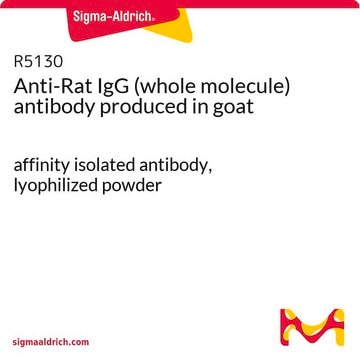This product is citrate stabilized gold colloid in 0.1 mM PBS.
753637
Gold nanoparticles
40 nm diameter, OD 1, stabilized suspension in 0.1 mM PBS, reactant free
Sinónimos:
Au NP, Gold colloid
Seleccione un Tamaño
138,00 €
Seleccione un Tamaño
About This Item
138,00 €
Productos recomendados
Nivel de calidad
Formulario
nanoparticles
suspension
concentración
~7.2E+10 particles/mL
DO
1
diámetro
40 nm
λmáx.
526-531 nm
temp. de almacenamiento
2-8°C
cadena SMILES
[Au]
InChI
1S/Au
Clave InChI
PCHJSUWPFVWCPO-UHFFFAOYSA-N
¿Está buscando productos similares? Visita Guía de comparación de productos
Categorías relacionadas
Descripción general
Aplicación
Información legal
Código de clase de almacenamiento
12 - Non Combustible Liquids
Clase de riesgo para el agua (WGK)
nwg
Punto de inflamabilidad (°F)
Not applicable
Punto de inflamabilidad (°C)
Not applicable
Elija entre una de las versiones más recientes:
¿Ya tiene este producto?
Encuentre la documentación para los productos que ha comprado recientemente en la Biblioteca de documentos.
Los clientes también vieron
Artículos
Steven J. Oldenburg, Ph.D. provides an overview of lateral flow diagnostic assays and discusses the use of ultra-bright reporter particles based on the unique optical properties of gold nanoshells that significantly increase the sensitivity of lateral flow immunoassays.
Sustainable energy sources with high production efficiency are crucial for meeting increasing energy demand.
Gold (Au) nanoparticles have tunable optical and electronic properties and are used in a number of applications including photovoltaics, sensors, drug delivery & catalysis.
Recent research highlights tunable properties of inorganic nanoparticles, driving interest in optoelectronics.
-
Are this gold nanoparticles citrate-stabilized?
1 respuesta-
¿Le ha resultado útil?
-
-
which size of particule is recommended for SERS?
1 respuesta-
We do not have a specific particle size of Gold Nanoparticle (AuNP) that is recommended for Surface-Enhanced Raman Spectroscopy. It is recommended to refer to the chemical literature to see what other researchers have used for this application.
To further discuss, we kindly ask you to navigate to the link https://www.sigmaaldrich.com/techservice, click on "Product Technical Inquires" under the Products Section with all the required information so that a member of our team can reach out to you to assist further. Thank you.
¿Le ha resultado útil?
-
-
How do you attach gold nanoparticles to peptides and peptide conjugates?
1 respuesta-
To view information on how to attach gold nanoparticles to peptides and peptide conjugates, please view the information in the reference - Rosenthal, S. J. and Wright, D. W. (Eds.). (2005), p. 91-92. NanoBiotechnology Protocols. New Jersey. Humana Press.
¿Le ha resultado útil?
-
-
How do you attach gold nanoparticles to oligos?
1 respuesta-
To attach gold nanoparticles to oligos please view the information in the attached reference - Bioconjug Chem. 2011 Apr 20;22(4):794-807. Epub 2011 Mar 28.
¿Le ha resultado útil?
-
-
Which gold nanoparticle size should I choose for my application?
1 respuesta-
The size of gold nanoparticle to use is very depandent upon the intended application. Generally, smaller particles offer better sensitivity in applications such as immunogold labeling due to less steric hindrance and the ability to bind more gold nanoparticles to the desired target. Small gold nanoparticles are less visible than larger particles, however, which must also be taken into account.As an application example, particles with a size between 30-50nm are particularly useful for the development of rapid tests such as lateral flow assays.
¿Le ha resultado útil?
-
-
What is the Department of Transportation shipping information for this product?
1 respuesta-
Transportation information can be found in Section 14 of the product's (M)SDS.To access the shipping information for this material, use the link on the product detail page for the product.
¿Le ha resultado útil?
-
-
Can the Gold nanoparticles be frozen?
1 respuesta-
No, the Gold nanoparticles should not be frozen. If frozen, the gold nanoparticles will irreversibly aggregate, turning the solution clear.
¿Le ha resultado útil?
-
-
How does the storage temperature relate to shipping conditions?
1 respuesta-
The storage conditions that a Sigma-Aldrich catalog and label recommend for products are deliberately conservative. For many products, long-term storage at low temperatures will increase the time during which they are expected to remain in specification and therefore are labeled accordingly. Where short-term storage, shipping time frame, or exposure to conditions other than those recommended for long-term storage will not affect product quality, Sigma-Aldrich will ship at ambient temperature. The products sensitive to short-term exposure to conditions other than their recommended long-term storage are shipped on wet or dry ice. Ambient temperature shipping helps to control shipping costs for our customers. At any time, our customers can request wet- or dry-ice shipment, but the special handling is at customer expense if our product history indicates that the product is stable for regular shipment.
¿Le ha resultado útil?
-
-
How do you attach gold nanoparticles to glass?
1 respuesta-
To view the procedure on how to attach gold nanoparticles to glass please view information in the reference - Journal of Atomic, Molecular, and Optical PhysicsVolume 2012 (2012). Article ID 683830, 6 pagesdoi:10.1155/2012/683830
¿Le ha resultado útil?
-
-
Do I need to wash my gold nanoparticles?
1 respuesta-
For most applications, our gold nanoparticles can be used without any additional washing steps. If you have a sensitive application that requires additional washing the best way to do so is by either centrifugation or filtration.
¿Le ha resultado útil?
-
Filtros activos
Nuestro equipo de científicos tiene experiencia en todas las áreas de investigación: Ciencias de la vida, Ciencia de los materiales, Síntesis química, Cromatografía, Analítica y muchas otras.
Póngase en contacto con el Servicio técnico


